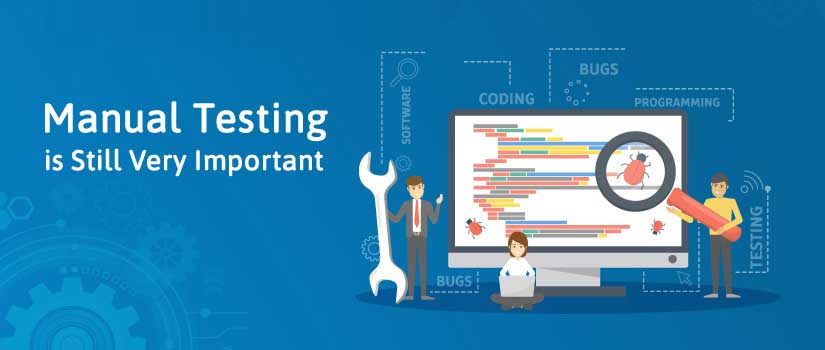Contrary to the popular belief, manual testing is still very important. Manual testing has numerous benefits over automated testing. It is one of the most important things you need to consider when building an app or software test strategy.
Particular tasks are indeed technically automated, but I think that is maybe because it’s difficult for the testers to use manual testing to test every single scenario in a certain phase. Every application has its ins and outs, black and white areas, grey areas, bugs, some minor and some fatal.
In this article, we will tell you why manual testing is still very important for the QA process. We do acknowledge the advantages of automation testing and how it can reduce some manual efforts. But manual testing is still a part of the QA process that should never be left out.
Why The Need For Manual Testing?
A lot of people think that the world of manual testing is dying and software has taken over. We beg to differ. Manual testing still has a lot to offer in this competitive era of technology. Factors like the need for accuracy and timely testing are just some of the elements that make manual testing so important in this fast-paced environment where people want everything done ASAP.
There are many types of software testing, but all have in common the process of executing a test methodically and reporting the results. Popular automated testing tools can help you achieve efficient and cheaper testing, however manual software testing still has an important place in the overall process of quality assurance.
Automatic testing is creating many new opportunities for testers. But manual testing has its own importance in the software development life cycle. It is the natural way of finding defects and humans are much able at doing it compared to machines.
Let us see why manual testing still holds vital importance in the QA process.
Some Testing Can Only Be Done Manually
We live in the age of automation with continuous integration, automated testing and deployment tools that are available for everyone to use. While these tools can be very useful, not everything can be automated.
Every QA tester has probably been involved in a discussion about the future of testing. On one side you’ll find people who believe that test automation is going to solve all our problems, and on the other, you’ll find others who believe manual testing will always be relevant because it can’t be replaced by any automated solution. Both of these points are true. Test automation is getting better every day but manual testing is still required in some cases.
However, the truth is you cannot automate everything. It is quite natural for most website owners and even some developers these days to completely rely on testing tools to automate the testing process. However, one should remember that some tests just cannot be replicated by a computer.
Manual testing is still an important part of the development process and will be essential as the digital space becomes more complex. Simply put, there are some things that only humans can do, but computers can’t.
Only Humans Can Interpret The True Use Of A Language
Manual testing is likely to play a role in the future. There are still non-technical requirements that can only be validated by a human. The rise of AI will undoubtedly bring about a revolutionary change to the IT industry. But there are still many issues that only a human can double-check. Language use is one of these areas.
Language is a difficult problem to solve. It changes over time, it can be ambiguous, and it’s impossible for computers to reliably check for correctness – only people can. This means that language errors still need to be tested manually and good manual testing will include a human double-check upon any automated testing.
With the explosion of online tools for performing every quality assurance inspection and testing, manual testing has been relegated to the shadows. This is a mistake, though, for many reasons. Manual tests allow you to understand your project in the context of how your user experiences it.
While most of the web performance and load testing tools can help us speed up our development process dramatically, we are still going to need manual testing. That’s because even though technology continues to advance at a rapid pace, technology as an entity is only capable of replicating what we humans allow them to do within time constraints.
Automated Testing Is A Supplement To Manual Testing
Automated testing is improving testing practices by leaps and bounds, making it easier to test more frequently. When Automated Unit Testing began in the field of software quality assurance (QA), manual testing was perceived as obsolete. However, there remains a need for manual testers who specialize in exploratory and usability testing.
A lot of automated testing still depends on human input: human testers are still needed to decide which tests will work best based on their knowledge of the product and the idea behind its development.
Building automated testing is often a necessary and beneficial step, but it's important not to forget the manual testing. Manual testers see the application from a different point of view than automated tester software. They test things that the automated software may not be entirely capable of testing.
A good automated testing tool will improve your efficiency and reduce the time needed for manual tests, but you also need to have skilled manual testers who can recognize a defect introduced by a newly added feature or enhanced functionality.
Manual testing can be conducted in various forms such as exploratory testing, sanity test or usability test, which are used to simulate real-life actions that a user would perform. That being said, automated testing does improve the quality of testing, but it should not be solely relied upon. Automated testing only helps to increase the efficiency of manual testing and not replace it.
Only Humans Can Identify Real Bugs
While Automated Testing Tools have made their way into every development process, the truth is that there are some bugs that only manual testing can identify. The number one reason why manual testing is still important because it is very useful for identifying complex defects, such as defects that can arise only under certain conditions or situations, and those that need coordinated efforts to rectify.
Despite their popularity and wide use, automated testing solutions have several shortcomings and manual testing is still the best way to locate bugs in applications.
An automated testing tool will check for the presence of a bug – but it won’t be able to denote its real-world effects. Other forms of testing such as code review are necessary to identify bugs. So don’t be afraid to use a manual approach as it can help you find and fix bugs that would have been a lot harder to fix with an automated test.
Usability and UX Testing
There are many reasons why you should conduct usability tests of software in manual mode and not rely only on automatic testing tools. When it comes to website usability and user experience testing, automated tools won't replace manual testing.
Software testing is not only about finding bugs, it’s about learning and understanding how users think and interact with your website. There are different types of usability testing but if you want to make sure your site is up to date you should consider a functional usability test as it will give you not only usability and user experience metrics but also valuable feedback on the effectiveness of your product in general.
Human-based testing is still the best way to ensure that the software or a webpage is easy to use for users. This is why human testing remains relevant whether you test a desktop or mobile application, a website or web page. Manual testing can help you to check that the application or website is easy to use and meet the expectations of your users.
Automated Test Can Be Error-Prone
The problem is that automated tests are only as good as the person testing them and the choices they make when writing the code to power them. When you decide to switch from automated tests to manual ones, you are reducing the chances of test errors.
Automated tests have a certain degree of reliability, but even the best-automated tools like Selenium, Appium or SauceLabs are susceptible to occasional errors. For instance, browser drivers may fail due to network problems and some tests are likely to crash even after running without any issues for ages which is why you should never rely solely on automated testing.
Automated tests are good when it comes to regression and compliance testing. However, automated tests can lead to false positives which can give you a wrong sense of security of the application being tested. Thorough manual testing is still very important in eliminating all possible test scenarios that automated tools will never find.
Automation is expensive
Automation has become the lingua franca of the software testing industry, as well as several others. When it comes to software testing automation is expensive. It's expensive to buy, implement, upgrade and maintain. For this reason, plenty of companies decide that manual testing is the way to go because it produces the same results while keeping their costs down - also no one likes to spend money after all.
While manual testing is old school, a tester needs to work with the system to execute tasks. Automation is good and effective, but it is costly. You should weigh the time of manual testing with automation to get the most out of it.
Testing On Multiple Platforms
Functional testing is a vital part of web development and helps in debugging the issues before the release. The core idea of testing a functional application is to check whether all the functionalities are performing as expected or not. This also includes testing on different browsers and devices to make sure they are rendering properly.
You want to know how your website will perform not only on the latest version of the browser but also on older versions and on various other browsers as well. And if you think that's enough, you may even want to check out HTML5, CSS3 and JavaScript interactive features that are available on your site. That's why a manual testing approach is still very important for creating a stable and bug-free product.
Automation Can Sometimes Waste Time Than Saving It
There is a difference between what is and what ought to be. We have certain expectations from technology that aren’t always met.
Automation systems are used more and more often in all areas. But even though you can run all or part of the checks on the website with their help, everything is not so simple.
Automation has its own problems: very often automation tests lag behind fast website development; it is difficult to provide access to a development environment to automated scripts. Manufacturers often create tools that do not meet real requirements because they focus on automation in the first place, and sometimes it is challenging to run things at the required pace.
Connectivity Issues
Connectivity issues are more common than you may think, and it can be surprisingly difficult to troubleshoot.
It can be network connectivity, connectivity between different components, slow website speed, or it can simply be an incompatibility. This makes your testing strategy very important. When this issue occurs, it is vital to have a solid knowledge of where and why the testing failed and that requires being able to identify and understand the component level. Even though automated tools do a good job at finding the bugs, they do not replace manual testing.
Connectivity problems are just a hassle and can be tricky to find and resolve. Automated tests also don't always emulate real user behaviour, which could result in your website not being accessible to users behind certain types of firewalls etc.
Conclusion
Manual testing is still very important in the QA process. It is because it allows us to look at our website from a different perspective—it allows us to look at our website like a real user. We should always try to think like our users. Why? Because there’s no one better suited to tell us what the problems are! We can have thousands of people giving us feedback, but nothing beats seeing your website through their eyes. A tester has an objective opinion, and if they're good, they can assess apps and websites for usability even when there's an abundance of content that isn't well organized.
Manual testing and automation are aimed at meeting different requirements and addressing different types of risks. However, both have a place in modern software quality strategy and can complement each other very well.
Manual testing is not obsolete, and it never will be. Many sources will tell you that soon software will automate all testing, but we're still far to achieve that goal.
Remember, machines can't do everything – they can only provide you with more efficiency and resources to supplement your work.
If you have questions about the significance of manual testing or need assistance with your testing strategy, feel free to reach out to us. We're here to guide you through the complexities of software testing and help you make informed decisions. Contact us for a consultation or any inquiries.











